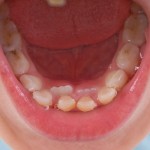
Dental caries in one of the worlds’ commonest diseases affecting 60-90% of children and almost all adults. Glass ionomer cements (GIC), including conventional glass ionomer cement (CGIC) and resin-modified glass ionomer cement (RMGIC) are commonly used to restore teeth affected by caries. Glass ionomers easy to use, adheres to teeth biocompatible and releases fluoride and have been developed since their introduction in 1969. The ability to release fluoride in the long-term means they may promote remineralisation and prevent new caries development.
The aim of this review was to assess the effectiveness of glass ionomer cement (GIC) restorations in preventing new caries in primary or permanent dentitions compared with other types of restorations.
Methods
A protocol was registered in PROSPERO and searches were conducted in the Cochrane, PubMed/ Medline, Scopus and Web of Science databases with no limitations. Two reviewers independently screened and selected studies extracted data and assessed risk of bias using the Cochrane domains-based tool. Randomised controlled trials (RCTs) assessing the new caries prevention effect of GIC/RMGIC restoration in the primary or permanent dentition were considered. Meta-analysis of the caries incidence after GIC restorations (CGIC or RMGIC) was conducted with risk ratio (RR) and 95% confidence intervals (CI) being reported.
Results
- 10 studies were included.
- 7 studies involved CGIC (2182 patients, 2655 restorations) with an average follow up of 3.3 years. Only one study involved the permanent dentition.
- 3 studies included RMGIC (271 patients, 328 restorations with an average follow up of 1.7 years. Only one study involved the permanent dentition.
- 3 studies were considered to be at low risk of bias and 7 at high risk of bias.
- 5 studies contributed to the meta-analysis
- Patients with GIC restorations showed a lower caries incidence compared with other types of restoration RR = 0.67 (95%CI; 0.55 to 0.82) [4 studies].
- Patients with CGIC restorations showed lower caries incidence in the primary dentition compared with
- Amalgam restorations RR= 0.57 (95%CI:0.43 to 0.76) [1 study]and
- RMGIC restorations RR= 0.70 95%CI:0.56 to 0.87) [1 study], but no difference with
- Composite resin restorations [RR=0.73 (95%CI:0.51 to 1.04) [1 study].
- Patients with RMGIC restorations showed no significant differences in caries incidence compared with composite resin restorations RR=0.83, 95%CI:0.56 to 1.22) [ 2 studies].
Conclusions
The authors concluded: –
Based on the limited evidence, GIC restorations have a better preventive effect on new caries compared to other restoration types in primary and permanent dentition. CGIC present a better preventive effect on new caries compared to RMGIC and amalgam restorations, but no statistical differences with composite resin restorations in primary dentition. RMGIC restorations showed no statistical differences in preventive effect on new caries compared with composite resin restorations in both primary and permanent dentitions.
Comments
The authors preregistered their review and searched a number of major databases identifying 10 RCTs addressing the question under review. Only 2 of the 10 studies related to the permanent teeth and only 3 studies involved the newer RMGIC. The findings from the 10 included studies were summarised narratively with only 5 studies contributing to the meta-analysis. The overall meta-analyses indicated a reduction in caries for GIC restorations compared with all other types of restoration. However, the comparisons of GIC against other individual restorative materials only include single studies. In addition, only 3 of the included studies were considered to be at low risk of bias. Consequently, the findings should be interpreted cautiously.
Links
Primary Paper
Ge KX, Quock R, Chu CH, Yu OY. The preventive effect of glass ionomer restorations on new caries formation: A systematic review and meta-analysis. J Dent. 2022 Aug 28;125:104272. doi: 10.1016/j.jdent.2022.104272. Epub ahead of print. PMID: 36038075.
